Khuong Vo
Deep Latent Variable Modeling of Physiological Signals
May 30, 2024Abstract:A deep latent variable model is a powerful method for capturing complex distributions. These models assume that underlying structures, but unobserved, are present within the data. In this dissertation, we explore high-dimensional problems related to physiological monitoring using latent variable models. First, we present a novel deep state-space model to generate electrical waveforms of the heart using optically obtained signals as inputs. This can bring about clinical diagnoses of heart disease via simple assessment through wearable devices. Second, we present a brain signal modeling scheme that combines the strengths of probabilistic graphical models and deep adversarial learning. The structured representations can provide interpretability and encode inductive biases to reduce the data complexity of neural oscillations. The efficacy of the learned representations is further studied in epilepsy seizure detection formulated as an unsupervised learning problem. Third, we propose a framework for the joint modeling of physiological measures and behavior. Existing methods to combine multiple sources of brain data provided are limited. Direct analysis of the relationship between different types of physiological measures usually does not involve behavioral data. Our method can identify the unique and shared contributions of brain regions to behavior and can be used to discover new functions of brain regions. The success of these innovative computational methods would allow the translation of biomarker findings across species and provide insight into neurocognitive analysis in numerous biological studies and clinical diagnoses, as well as emerging consumer applications.
PPG to ECG Signal Translation for Continuous Atrial Fibrillation Detection via Attention-based Deep State-Space Modeling
Sep 27, 2023Abstract:An electrocardiogram (ECG or EKG) is a medical test that measures the heart's electrical activity. ECGs are often used to diagnose and monitor a wide range of heart conditions, including arrhythmias, heart attacks, and heart failure. On the one hand, the conventional ECG requires clinical measurement, which restricts its deployment to medical facilities. On the other hand, single-lead ECG has become popular on wearable devices using administered procedures. An alternative to ECG is Photoplethysmography (PPG), which uses non-invasive, low-cost optical methods to measure cardiac physiology, making it a suitable option for capturing vital heart signs in daily life. As a result, it has become increasingly popular in health monitoring and is used in various clinical and commercial wearable devices. While ECG and PPG correlate strongly, the latter does not offer significant clinical diagnostic value. Here, we propose a subject-independent attention-based deep state-space model to translate PPG signals to corresponding ECG waveforms. The model is highly data-efficient by incorporating prior knowledge in terms of probabilistic graphical models. Notably, the model enables the detection of atrial fibrillation (AFib), the most common heart rhythm disorder in adults, by complementing ECG's accuracy with continuous PPG monitoring. We evaluated the model on 55 subjects from the MIMIC III database. Quantitative and qualitative experimental results demonstrate the effectiveness and efficiency of our approach.
Decision SincNet: Neurocognitive models of decision making that predict cognitive processes from neural signals
Aug 17, 2022



Abstract:Human decision making behavior is observed with choice-response time data during psychological experiments. Drift-diffusion models of this data consist of a Wiener first-passage time (WFPT) distribution and are described by cognitive parameters: drift rate, boundary separation, and starting point. These estimated parameters are of interest to neuroscientists as they can be mapped to features of cognitive processes of decision making (such as speed, caution, and bias) and related to brain activity. The observed patterns of RT also reflect the variability of cognitive processes from trial to trial mediated by neural dynamics. We adapted a SincNet-based shallow neural network architecture to fit the Drift-Diffusion model using EEG signals on every experimental trial. The model consists of a SincNet layer, a depthwise spatial convolution layer, and two separate FC layers that predict drift rate and boundary for each trial in-parallel. The SincNet layer parametrized the kernels in order to directly learn the low and high cutoff frequencies of bandpass filters that are applied to the EEG data to predict drift and boundary parameters. During training, model parameters were updated by minimizing the negative log likelihood function of WFPT distribution given trial RT. We developed separate decision SincNet models for each participant performing a two-alternative forced-choice task. Our results showed that single-trial estimates of drift and boundary performed better at predicting RTs than the median estimates in both training and test data sets, suggesting that our model can successfully use EEG features to estimate meaningful single-trial Diffusion model parameters. Furthermore, the shallow SincNet architecture identified time windows of information processing related to evidence accumulation and caution and the EEG frequency bands that reflect these processes within each participant.
Deep learning-based framework for cardiac function assessment in embryonic zebrafish from heart beating videos
Feb 24, 2021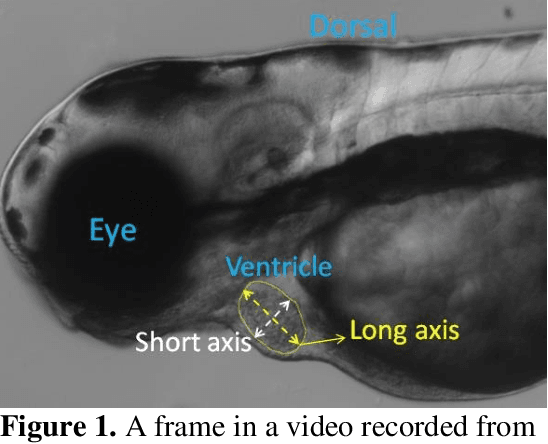
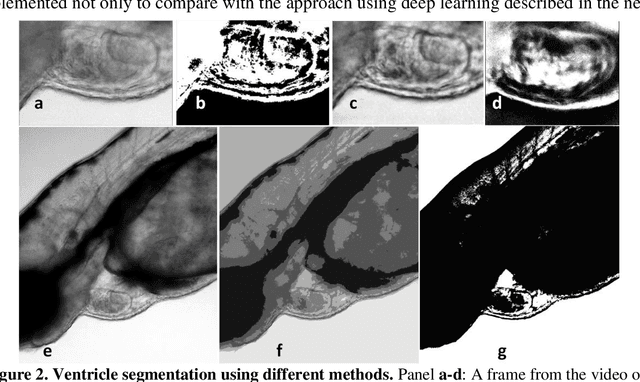
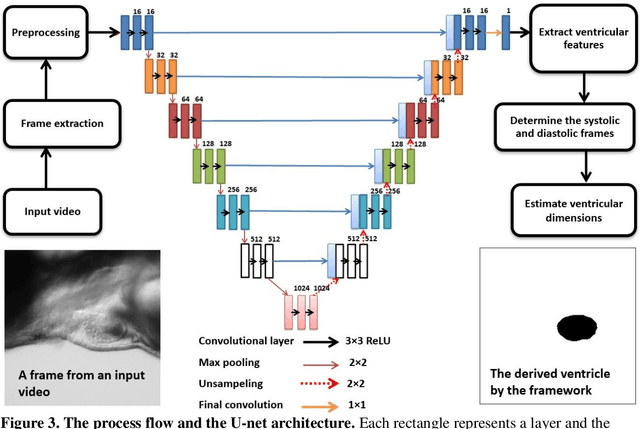

Abstract:Zebrafish is a powerful and widely-used model system for a host of biological investigations including cardiovascular studies and genetic screening. Zebrafish are readily assessable during developmental stages; however, the current methods for quantification and monitoring of cardiac functions mostly involve tedious manual work and inconsistent estimations. In this paper, we developed and validated a Zebrafish Automatic Cardiovascular Assessment Framework (ZACAF) based on a U-net deep learning model for automated assessment of cardiovascular indices, such as ejection fraction (EF) and fractional shortening (FS) from microscopic videos of wildtype and cardiomyopathy mutant zebrafish embryos. Our approach yielded favorable performance with accuracy above 90% compared with manual processing. We used only black and white regular microscopic recordings with frame rates of 5-20 frames per second (fps); thus, the framework could be widely applicable with any laboratory resources and infrastructure. Most importantly, the automatic feature holds promise to enable efficient, consistent and reliable processing and analysis capacity for large amounts of videos, which can be generated by diverse collaborating teams.
Combination of Domain Knowledge and Deep Learning for Sentiment Analysis of Short and Informal Messages on Social Media
Feb 16, 2019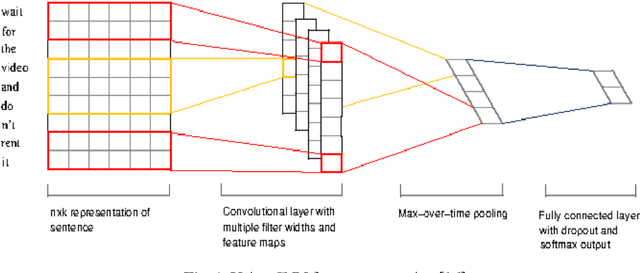
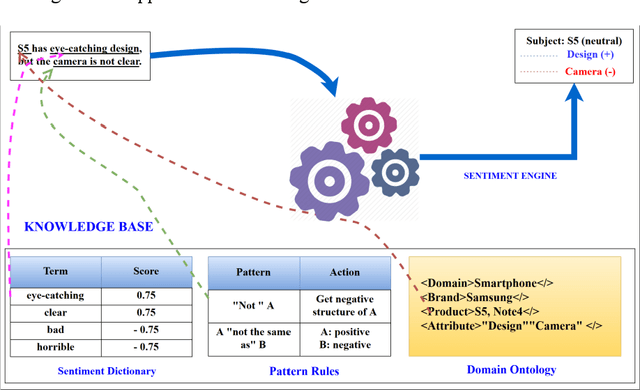

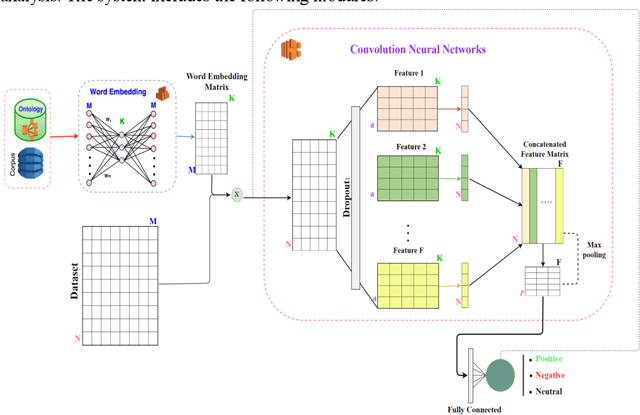
Abstract:Sentiment analysis has been emerging recently as one of the major natural language processing (NLP) tasks in many applications. Especially, as social media channels (e.g. social networks or forums) have become significant sources for brands to observe user opinions about their products, this task is thus increasingly crucial. However, when applied with real data obtained from social media, we notice that there is a high volume of short and informal messages posted by users on those channels. This kind of data makes the existing works suffer from many difficulties to handle, especially ones using deep learning approaches. In this paper, we propose an approach to handle this problem. This work is extended from our previous work, in which we proposed to combine the typical deep learning technique of Convolutional Neural Networks with domain knowledge. The combination is used for acquiring additional training data augmentation and a more reasonable loss function. In this work, we further improve our architecture by various substantial enhancements, including negation-based data augmentation, transfer learning for word embeddings, the combination of word-level embeddings and character-level embeddings, and using multitask learning technique for attaching domain knowledge rules in the learning process. Those enhancements, specifically aiming to handle short and informal messages, help us to enjoy significant improvement in performance once experimenting on real datasets.
Combination of Domain Knowledge and Deep Learning for Sentiment Analysis
Jun 26, 2018



Abstract:The emerging technique of deep learning has been widely applied in many different areas. However, when adopted in a certain specific domain, this technique should be combined with domain knowledge to improve efficiency and accuracy. In particular, when analyzing the applications of deep learning in sentiment analysis, we found that the current approaches are suffering from the following drawbacks: (i) the existing works have not paid much attention to the importance of different types of sentiment terms, which is an important concept in this area; and (ii) the loss function currently employed does not well reflect the degree of error of sentiment misclassification. To overcome such problem, we propose to combine domain knowledge with deep learning. Our proposal includes using sentiment scores, learnt by regression, to augment training data; and introducing penalty matrix for enhancing the loss function of cross entropy. When experimented, we achieved a significant improvement in classification results.
A NoSQL Data-based Personalized Recommendation System for C2C e-Commerce
Jun 26, 2018



Abstract:With the considerable development of customer-to-customer (C2C) e-commerce in the recent years, there is a big demand for an effective recommendation system that suggests suitable websites for users to sell their items with some specified needs. Nonetheless, e-commerce recommendation systems are mostly designed for business-to-customer (B2C) websites, where the systems offer the consumers the products that they might like to buy. Almost none of the related research works focus on choosing selling sites for target items. In this paper, we introduce an approach that recommends the selling websites based upon the item's description, category, and desired selling price. This approach employs NoSQL data-based machine learning techniques for building and training topic models and classification models. The trained models can then be used to rank the websites dynamically with respect to the user needs. The experimental results with real-world datasets from Vietnam C2C websites will demonstrate the effectiveness of our proposed method.
 Add to Chrome
Add to Chrome Add to Firefox
Add to Firefox Add to Edge
Add to Edge